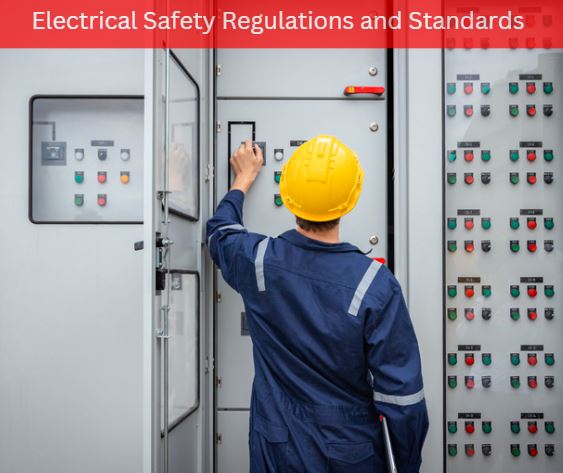Electrical Safety Regulations and Standards
Introduction
Electrical safety regulations and standards are an essential aspect of workplace safety, and adherence to these standards can prevent workplace accidents and injuries. In the United States, organizations such as OSHA and NFPA have established electrical safety regulations and standards that companies must follow to ensure the safety of their employees. Similarly, the International Electrotechnical Commission (IEC) has developed international standards to promote electrical safety worldwide.
In this article, we will discuss electrical safety regulations and standards, including those set by OSHA, NFPA, and IEC, their importance, and the impact they have on workplace safety.

Overview of OSHA electrical safety regulations and standards:
OSHA (Occupational Safety and Health Administration) is the federal agency responsible for regulating workplace safety and health in the United States. OSHA’s role in regulating electrical safety is to ensure that employers provide a safe working environment for employees who work with or around electrical equipment and machinery.
OSHA’s electrical safety standards are set forth in 29 CFR 1910.303-308, which cover the installation, maintenance, and use of electrical equipment in the workplace. These standards establish requirements for the design, construction, installation, and use of electrical equipment, including grounding, insulation, and circuit protection. The standards also require that employees be trained in electrical safety and that proper personal protective equipment (PPE) be worn when working with or around electrical equipment.
Examples of OSHA electrical safety violations and penalties include failure to provide appropriate PPE, failure to properly install and maintain electrical equipment, and failure to provide adequate training for employees. Penalties for OSHA violations can range from fines to criminal charges, depending on the severity of the violation and the harm caused to employees.
Overview of NFPA electrical safety regulations and standards:
The NFPA (National Fire Protection Association) is a nonprofit organization that develops and publishes codes and standards related to fire protection, electrical safety, and other areas of public safety. The NFPA’s role in developing electrical safety standards is to provide guidance and best practices for ensuring safe electrical work practices and environments.
One of the most well-known NFPA electrical safety standards is NFPA 70E: Standard for Electrical Safety in the Workplace. This standard provides guidance on how to protect workers from electrical hazards by identifying and assessing risks associated with electrical work, selecting appropriate PPE, and establishing safe work practices. The standard also requires regular electrical safety training for employees.
Examples of NFPA electrical safety standards and their impact on workplace safety include the requirement for arc flash hazard analysis and the use of appropriate PPE, the requirement for equipment labeling to indicate potential electrical hazards, and the requirement for regular inspections and maintenance of electrical equipment.
Overall, both OSHA and NFPA electrical safety regulations and standards play a critical role in ensuring the safety of employees who work with or around electrical equipment and machinery. Employers should be aware of and comply with these regulations to prevent electrical hazards and promote a safe work environment.
Overview of IEC electrical safety regulations and standards:
The IEC (International Electrotechnical Commission) is an international organization that develops and publishes global electrical safety standards. The IEC’s role in developing international electrical safety standards is to ensure that electrical equipment and installations are safe and reliable across international borders.
One of the most well-known IEC electrical safety standards is IEC 60364: Low-voltage electrical installations, which provides guidance on the design, installation, and maintenance of low-voltage electrical installations. This standard covers a wide range of topics, including protection against electric shock, protection against overcurrent, protection against voltage disturbances and electromagnetic disturbances, and more.
Examples of IEC electrical safety standards and their impact on global safety include the requirement for electrical equipment and installations to meet certain safety standards before being sold or used in international markets, the requirement for electrical equipment to be designed and tested to ensure safety, and the requirement for regular inspections and maintenance of electrical equipment.
Comparison of OSHA, NFPA, and IEC electrical safety regulations and standards:
OSHA, NFPA, and IEC electrical safety regulations and standards all play important roles in promoting electrical safety in the workplace. While there may be some differences between the three standards, they generally share the same goals of preventing electrical hazards and ensuring a safe work environment.
Some similarities between the three standards include the requirement for proper electrical equipment installation and maintenance, the requirement for employees to receive training on electrical safety, and the requirement for appropriate PPE when working with or around electrical equipment.
Some differences between the standards include the level of detail provided in the regulations, the scope of the regulations (i.e. whether they apply to a specific industry or all industries), and the geographic location covered by the regulations (i.e. OSHA covers the United States, while IEC covers international markets).
Companies can comply with multiple electrical safety standards by identifying the similarities and differences between the standards and implementing policies and procedures that address all of the requirements. This may involve working with electrical safety experts and conducting regular assessments of the workplace to ensure compliance with all relevant standards.
FAQs
What is the NFPA standard for electrical safety?
The NFPA standard for electrical safety is NFPA 70E: Standard for Electrical Safety in the Workplace.
What are the 5 electrical safety rules?
The 5 electrical safety rules are:
- Always assume that electrical devices are live.
- Make sure to de-energize equipment before working on it.
- Use personal protective equipment (PPE) when working with electrical equipment.
- Follow proper lockout/tagout procedures when working on electrical equipment.
- Only qualified and authorized personnel should work on electrical equipment.
What is the OSHA standard for electrical panels?
The OSHA standard for electrical panels is 29 CFR 1910.303(g)(2).
What are the standards used in electrical systems?
There are several standards used in electrical systems, including the National Electrical Code (NEC), the International Electrotechnical Commission (IEC), and the Institute of Electrical and Electronics Engineers (IEEE) standards.
What are the 8 electrical hazards?
The 8 electrical hazards are:
- Shock
- Electrocution
- Burns
- Explosions
- Fires
- Arc flashes
- Electromagnetic fields
- Power surges
What are the three types of electrical safety?
The three types of electrical safety are:
- Equipment safety
- System safety
- Personal safety
What are 4 electrical safety steps?
The 4 electrical safety steps are:
- Identify potential electrical hazards
- Evaluate the risks associated with those hazards
- Implement control measures to reduce or eliminate the risks
- Monitor and maintain the effectiveness of the control measures
What does NFPA standard mean?
NFPA stands for the National Fire Protection Association, which is a nonprofit organization that develops and publishes codes and standards related to fire protection, electrical safety, and other areas of public safety.
What is NFPA classification?
NFPA classification is a system used by the National Fire Protection Association to classify the hazards associated with different types of materials and substances.
What is NFPA 22 code?
NFPA 22 is a code that specifies the requirements for the design, construction, installation, and maintenance of water tanks used for fire protection purposes.
Conclusion
In conclusion, electrical safety regulations and standards are crucial in preventing workplace accidents and injuries. OSHA, NFPA, and IEC have developed standards to regulate electrical safety, and companies must adhere to these standards to ensure the safety of their employees. Compliance with these standards can result in reduced workplace accidents, increased productivity, and improved employee morale. As technology continues to evolve, electrical safety regulations and standards must also evolve to keep up with new risks and hazards. It is essential for companies to prioritize compliance with electrical safety regulations and standards to promote workplace safety and protect their employees.
 Electrical Engineering World Wiring a Brighter Tomorrow!
Electrical Engineering World Wiring a Brighter Tomorrow!


